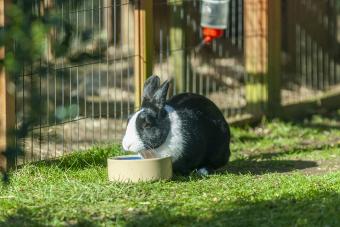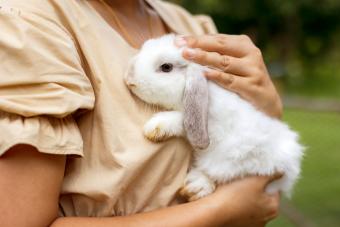
The Havana rabbit is a soft, silky breed that makes a wonderful pet for those who appreciate their unique features and kind-hearted nature. They are known to be easy to handle, making this breed great for anyone who wants a small, gentle bunny that's unbelievably soft to the touch. They're not overly energetic, but they enjoy playing with their families from time to time.
Origin and History
You might be thinking the Havana rabbit must have been developed in Cuba. But the breed's name doesn't relate to where it's from: actually, Havanas are named after the famous brown cigars from the island nation.
Havana rabbits most likely originated in the Netherlands in the early 20th century when a Dutch rabbit breeder found that some of the rabbits in a litter had a unique, rich chocolate-colored coat. Rabbit breeders began to selectively breed these rabbits to develop and refine the breed you know today.
The first Havanas arrived in the United States in 1916, where the breed continued to grow in popularity among rabbit lovers. The Havana is not a rare breed, and can be found quite readily in most places.
Havana rabbits are among the oldest breeds in the American Rabbit Breed's Association, and their breed club is also among the oldest.
Appearance and Physical Traits
Havana rabbits have a well-rounded body with a short, strong neck and medium-length ears that stand upright. They're body type is compact in the breed definition, even though they are in the medium category.
Size and Weight
They're sometimes referred to as "dwarf" Havana rabbits, but they're actually a medium-sized to large breed, on average. Havana rabbits weigh in between 4½ to 6½ pounds when fully grown.
Coat Colors
Havanas have very soft, almost velvety or silky coats, often described as "mink-like." They're primarily a rich brown, but they come in several recognized colors, including:
- Chocolate
- Blue
- Black
- Lilac
- Broken
Havanas may also have a combination of one of the solid colors with white, which is the "Broken" category.
Unique Characteristics
One of the most striking features of the Havana rabbit is its coat. The fur is short, dense, and incredibly soft, with a luxurious, silky texture. They're also known to be the most gentle breed in the rabbit world.
Care Basics
Havana rabbits are known to be easy to care for, but can be demanding of attention. They're loving bunnies, so be ready to spend some time with these silk wonders.
Diet
Havana rabbits require about ¼ cup of high-quality rabbit pellets per day along with vegetables, hay, and fresh water. You can offer dark, leafy green veggies on a regular basis. Other vegetables should only be offered occasionally. You can keep water in a bowl or a bottle, but it must be kept fresh at all times.
Treats and colored vegetables should never go over 5% of your Havana's daily diet.
Enclosure
Your Havana rabbit should have an enclosure that's at least 3 feet by 3 feet so they can hop and move around freely. Outdoor rabbit hutches can be purchased or built, but if your rabbit is housed outdoors, you must ensure predators cannot get in and the rabbits can't get out.
The bottom of the enclosure should not contain wire as this could lead to foot problems. You should also allow your rabbit to spend time outside their enclosure whether indoors or outdoors.
Grooming
These rabbits have low grooming requirements. As long as they're brushed twice per week, their slick fur remains silky and smooth.
Behavior and Handling
Havana rabbits are known for their calm and gentle nature. They are friendly and sociable animals, making them an excellent choice for families with children. Havanas are intelligent and can be trained to perform simple tricks and commands, such as coming when called or using a litter box.
Socialization
Socializing your pet rabbit is essential for their overall well-being and happiness. Rabbits are social creatures by nature, and providing them with positive human interaction and opportunities to bond with other rabbits can significantly improve their quality of life. Tips for socialization include:
- Socialize when they're young: The best time to begin socializing your rabbit is when they are young. Young rabbits tend to be more open to new experiences and can more easily adapt to various social situations. However, older rabbits can also benefit from socialization, albeit with a little more patience and care.
- Adopt more than one bunny: Rabbits can form strong bonds with other rabbits, so consider adopting a companion for your pet rabbit. It's essential to choose a compatible partner, ideally of a similar size and temperament.
-
Socialization sessions: Schedule regular socialization sessions for your rabbit, where they can interact with different people and animals in a controlled setting. This will help them become more accustomed to various social situations and reduce the likelihood of fear or aggression.
Health
Havana rabbits are a well established breed that doesn't have a lot of genetic predisopsitions to disease. However, they are prone to the following health conditions:
- Ear mites
- Skin mites
- Ileus: Also called gastrointestinal stasis, ileus occurs when the intestines stop moving food through the colon.
- Respiratory problems
This rabbit breed cannot tolerate extreme temperatures; hot or cold.
Lifespan
Havana rabbits are in the middle of the pack when it comes to average lifespan. They typically live 8 to 10 years on average, though well-kept members of the breed can see greater spans of longevity.
Availability and Cost
Even though they're very common in the rabbit-keeping community, you likely won't find a Havana rabbit at your local pet store. They're more likely to be found at a rabbit show or a breeder. You can also contact your local House Rabbit Society to inquire about local rabbit rescue organizations. You should expect to pay between $20 to $100.
Is a Havana Rabbit Right for You?
If you are searching for a rabbit that enjoys attention and is easy to handle, the Havana rabbit could be perfect for you. This breed is also exceptional for children who know how to handle rabbits properly. However, if you're searching for a rabbit that's more on the independent side, you may want to consider another breed.







